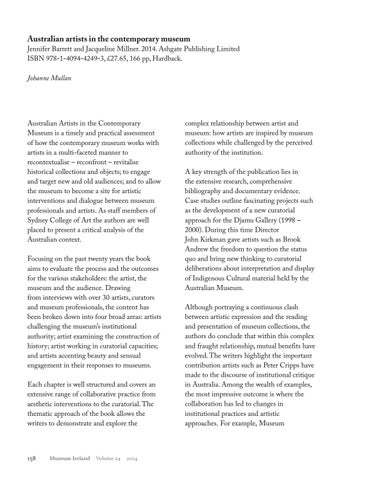Australian artists in the contemporary museum jennifer Barrett and jacqueline Millner. 2014. Ashgate Publishing Limited ISBN 978-1-4094-4249-3, £27.65, 166 pp, Hardback. Johanne Mullan
Australian Artists in the Contemporary Museum is a timely and practical assessment of how the contemporary museum works with artists in a multi-faceted manner to recontextualise – reconfront – revitalise historical collections and objects; to engage and target new and old audiences; and to allow the museum to become a site for artistic interventions and dialogue between museum professionals and artists. As staff members of Sydney College of Art the authors are well placed to present a critical analysis of the Australian context. Focusing on the past twenty years the book aims to evaluate the process and the outcomes for the various stakeholders: the artist, the museum and the audience. Drawing from interviews with over 30 artists, curators and museum professionals, the content has been broken down into four broad areas: artists challenging the museum’s institutional authority; artist examining the construction of history; artist working in curatorial capacities; and artists accenting beauty and sensual engagement in their responses to museums. Each chapter is well structured and covers an extensive range of collaborative practice from aesthetic interventions to the curatorial. The thematic approach of the book allows the writers to demonstrate and explore the
158
Museum Ireland
Volume 24 2014
complex relationship between artist and museum: how artists are inspired by museum collections while challenged by the perceived authority of the institution. A key strength of the publication lies in the extensive research, comprehensive bibliography and documentary evidence. Case studies outline fascinating projects such as the development of a new curatorial approach for the Djamu Gallery (1998 – 2000). During this time Director john kirkman gave artists such as Brook Andrew the freedom to question the status quo and bring new thinking to curatorial deliberations about interpretation and display of Indigenous Cultural material held by the Australian Museum. Although portraying a continuous clash between artistic expression and the reading and presentation of museum collections, the authors do conclude that within this complex and fraught relationship, mutual benefits have evolved. The writers highlight the important contribution artists such as Peter Cripps have made to the discourse of institutional critique in Australia. Among the wealth of examples, the most impressive outcome is where the collaboration has led to changes in institutional practices and artistic approaches. For example, Museum













